SPSS Tutorial
Listing Variables | Tutorial Main Menu | Training Homepage | Creating Scatter Plots
Section Five: Analyzing a Dataset
In this section, we will cover how to perform an analysis of a dataset. As our sample data, we will use the file we created in Section Two.
Performing a Basic (Univariant) Analysis

Figure 5-1
To perform an analysis, click on the Analyze menu to reveal the various statistical analyses that you can perform. For the purpose of this tutorial, we will be performing a frequency analysis.
Selecting this particular option allows you to analyze variables individually, rather than in relation to another variable. Performing this analysis, you can measure individual properties such as mean, median, mode, etc. To access this function, select Frequencies under Descriptive Statistics.

Figure 5-2
Once the Frequencies window appears, you can add the variables you would like to include in the analysis, moving them from the left list to the right by clicking the arrow. If you decide you don't want to include a variable you have added after all, simply select the variable in the right list, and click the arrow to move it back over to the left. Alternatively, you can simply double-click on the variables to move them. When you're finished, click OK.

Figure 5-3
The output window should then appear, displaying the results of your analysis. Clicking on the + sign beside Frequencies on the left will give you the option of viewing a particular section of the analysis. Click on a section heading to jump to it.

Figure 5-4
To save your analysis, open the File menu in the output window and click on Save.
Note. If you do not close the output window after saving your analysis, any further analyses performed will be added to the one already existing in the output window.
More Statistical Options for Univariant Analyses
You can display more statistical information in your analysis than that which is provided by default. As our example dataset, we will use the GSS 2008 dataset. This file can either be found on the Y: drive under GSS > GSS2008, or on the General Social Survey download website, which can be accessed by clicking here.

Figure 5-5
Once the dataset has been opened, open the Analyze menu, and click on the Frequencies option under Descriptive Statistics.

Figure 5-6
The Frequencies window will now appear. If you have not permanently changed how variables are listed (see Section Four: Changing How Variables are Listed), and want to temporarily view the variables differently, right click on the left column. By selecting Display Variable Names and Sort Alphabetically, you can more easily find the variables you are looking for.

Figure 5-7
In this example, we will perform a frequency analysis of the respondent's age and zodiac sign. Selecting these two variables, move them from the left list to the right by clicking the arrow.

Figure 5-8
Then, click on the Statistics button on the right.

Figure 5-9
The Statistics window will appear, giving you advanced statistical options for your analysis. In our example, we will be selecting mean, median, and mode. When finished, click Continue to return to the Frequencies window. Once there, click OK to begin the analysis.

Figure 5-10
The output window will now appear, showing the results of your analysis.
Performing a Bivariant Analysis
Now that we have covered the basics of analyzing data, we will perform a bivariant analysis on the large dataset "GSS 2008."

Figure 5-11
Once the dataset has been opened, open the Analyze menu, and click on the Crosstabs option under Descriptive Statistics.

Figure 5-12
When the Crosstabs window appears, right-click in the box on the left and uncheck Prefer variable labels, in order to make the variables easier to spot. Then, select the variable "Sex," and clicking on the top arrow, move it from the box on the left to the Row box on the top right. Going back to the left box again, select the variable "Zodiac," and click on the bottom arrow to move it over to the Columns box on the bottom right. Remember, the dependent variable goes into the Columns box, while the independent variable always goes into the Row box. When finished, click OK.

Figure 5-13
Changing the Cell Display

Figure 5-14
To change the cell display, click on the Cells button in the Crosstabs window.

Figure 5-15
From here, you can select whatever display options you would like, and then click Continue.
More Statistical Options for Bivariant Analyses

Figure 5-16
As with univariant analyses, you can access more advanced statistical options for bivariant analyses by clicking on the Statistics button, this time from the Crosstabs window.

Figure 5-17
Since the "Chi-square" (Chisq) function is one of the more commonly used functions, we will select it, and click Continue.
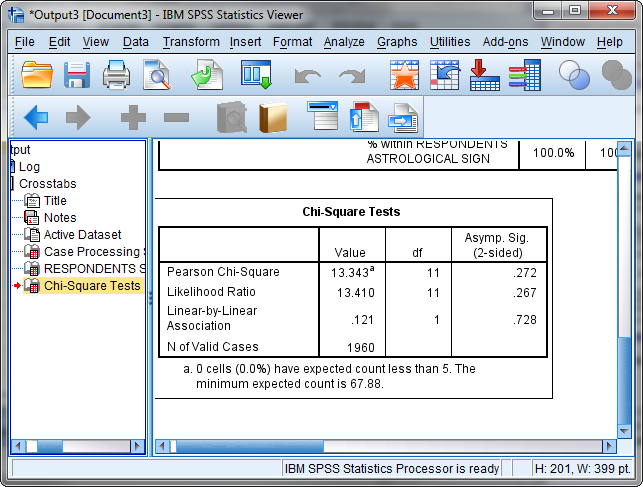
Figure 5-18
The results of your analysis should now appear in the Output window, under the heading Chi-Square Tests.
Recoding the Dataset
Analysis may also be performed by recoding the dataset, particularly if the amount of data is very substantial, in order to make it easier to work with.
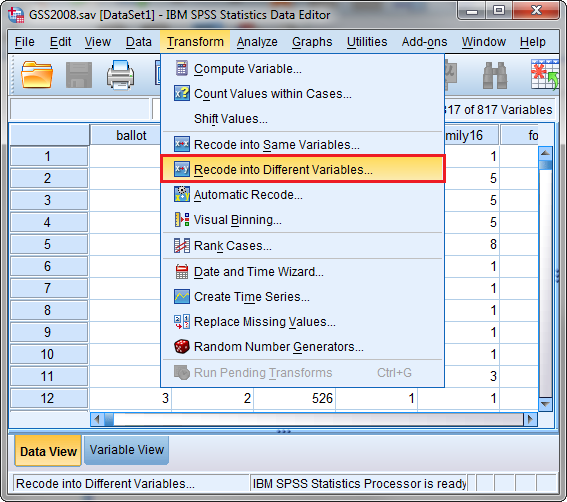
Figure 5-19
To recode a large dataset into different variables, first open the Transform menu, and then select Recode into Different Variables.

Figure 5-20
Once the window appears, select the variable you would like to recode, and then click on the arrow to move it to the Variables box on the right. In this case, we will select "Zodiac."
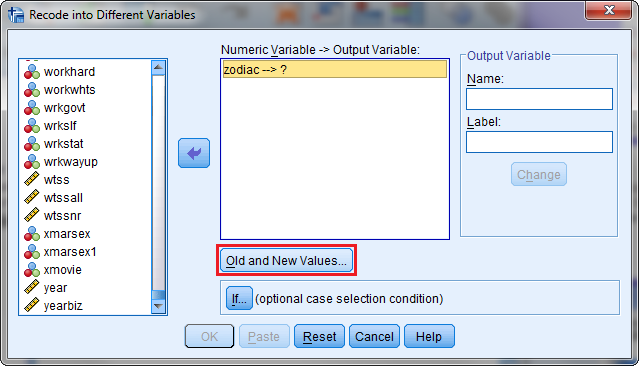
Figure 5-21
After the variable has been moved over to the right, click on the Old and New Values button.
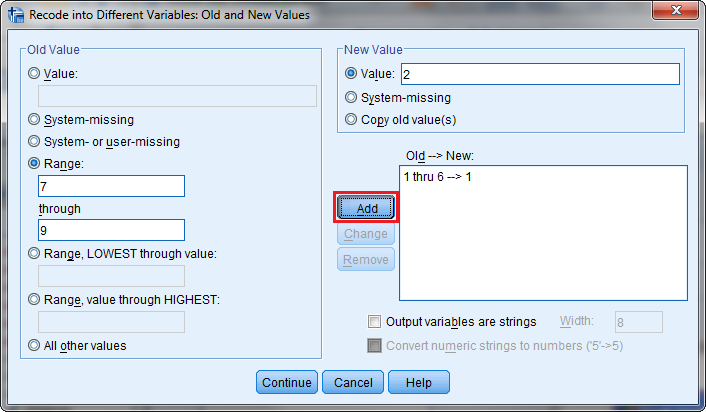
Figure 5-22
You may now enter the old and new values for your variable. In addition, you can also select a range of values, assigning a new value to that range. In this example, we will first input a range of 1 through 6 in the Old Value column, and assign a new value of 1 on the right. Then, click Add. Second, we will input 7 through 9 under the range of the old value, entering a new value of 2, and click Add again. When finished, click on Continue.
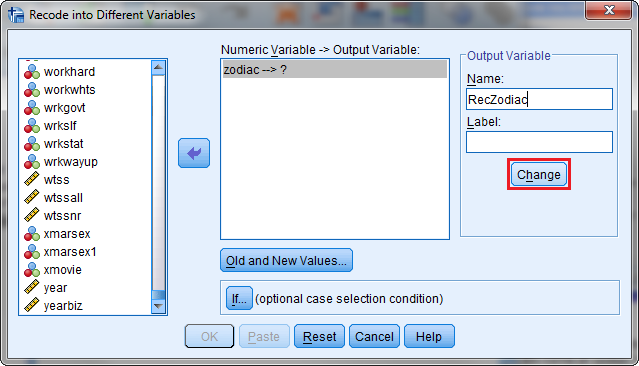
Figure 5-23
Now that the variable has been recoded, you will need to assign a name to it, in this example we will use the name "RecZodiac." Then, click Change. Click OK when finished.

Figure 5-24
Using our newly-recoded variable, we will now perform a frequency analysis of "age" and "RecZodiac." Access the Frequencies window by clicking on Analyze from the main menu, and selecting the Frequencies option under Descriptive Statistics (see Fig. 5-5 above). When the window appears (see Fig. 5-24 above), first select the "Age" variable, clicking the arrow to move it to the Variable(s) box on the right. Then, do the same for the "RecZodiac" variable. When finished, click OK.
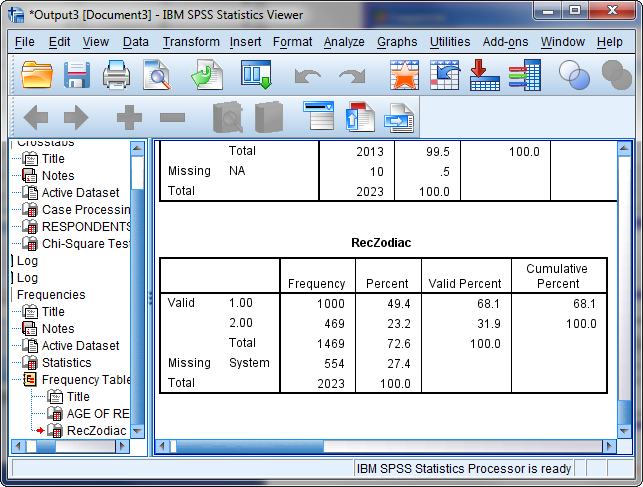
Figure 5-25
The results of your analysis will then appear in the output window.